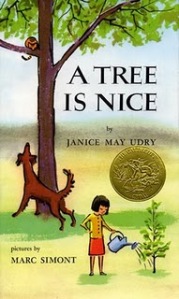The simplicity of Janice Udry’s story published in 1956, should not be considered irrelevant for today’s young reader. This story captures many wonderful things about trees and does so in a way kids know and recognize. For most adults, the story is not immediately seen, but to a young reader the story is known–trees are amazing things and we are surrounded by them. Udry portrays trees as things to play on, things we grow, things that have limbs and trunks, and things that whisper. It is a simple, well-written book easily understood by young readers. Marc Simont’s watercolor sketches highlight the narrative and do so with vivid, bold colors alternating with muted colors from page to page.
This book was awarded the Caldecott in 1957 and the illustrations are still loved by children today.
Insight:
Many authors that write books these days always seem to want their books to convey some deep, symbolic meaning or grapple a controversial issue. This book–not so much. It is a quiet and simple book for young readers with the apt title, “A Tree Is Nice.” Children today are always wanting to be entertained through video games, t.v., music or some electronic device that does nothing for the imagination. This book has a distinct quietness, with its beautiful illustrations and simple message of appreciating and admiring things in life for their simple beauty. This story with its simple text and beautiful illustrations is one of my favorite stories. No hidden messages– just a good solid read.
Suggested Library Activity:
After taking students on a walk outside, let them create their own trees using watercolors and various media. A book of different leaf rubbings is another activity students can do.
Bibliographic Citation:
Udry, J. (1956). A tree is nice. New York: Harper & Brothers.
Additional Book Review:
A Tree is nice seems rather too plain for a title for children. Nothing fancy or funny. But its this quality that’s held in all earnestness up until the end that also makes the book enjoyable, without laboring to interpret or analyze.
The book is a Caldecott winner and this calls for dissecting the illustration. Color and black-and-whites alternate; ink drawings draped in gray, follow and precede beautiful watercolors. Especially the watercolors, they glorify the foliage in varying seasons with splurges of warm greens, sometimes with flaming reds and bright yellows in their midst. The book is 11×7 inches in size. This allows for generous detailing of the trunks and twisted branches in varying dimensions, in browns that remind us of barks of dark chocolate. Something about the book gives us that warmth – the thick dirty white paper with rawness resembling recycled material, and the uncomplicated content of the drawings and writing, I think. The fact that is was published in 1956 connects the dots.
Book Review A Tree Is Nice. (2011, April 22). Message retrieved from http://www.saffrontree.org/2011/04/tree-is-nice.html
Publishers Weekly (June 12, 1987)
The Caldecott award-winning book that speaks simply and elegantly of the many pleasures a tree provides. Ages 4-8. (June)


